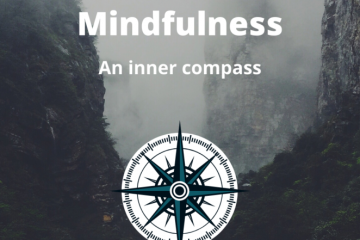A tough year for us all has gone by since March 2020. Learning to deal and live with physical distancing, home-schooling and home-office, loss of jobs and income, the pain at losing some-one and not being able to clasp our parents, children or grandparents in our arms. A year of isolation and loneliness and the effects of lack of social engagement, contact and human touch. A year in which mental health, fear and worry posed as great a crisis as overflowing hospital-beds and deaths due to Corona.
Uncertainty, constant change and lack of security trigger difficult emotions, which when not dealt with can lead to anxiety, fear and depression.
Mindfulness is one way to cultivate our minds to resist being pulled into the negative spirals created by thoughts and emotions and to rest our attention in the present moment, which is the only moment we have. Our minds are usually in the past or future, in memories or dwelling in “should have” or “could have” scenarios or speculating about the future. And then there is the autopilot, which causes a mechanical functioning of body and mind, often lifesaving, sometimes not helpful, especially when we lose ourselves in the treadmill of our daily existence.
In the midst of the outer turmoil and disruption, bringing awareness to what is currently arising, can bring moments of stillness to the mind. Mindfulness re-establishes and strengthens the relationship between the body, the mind and thought-flow, emotions and attitude in dealing with the reality of our lives.
The power of thinking
New research identified “thought worms” which showed that the average person has about 6000 individual thoughts a day (J. Poppenk, Queens University of Canada, 2020)1. Older research speaks of between 12000 to 60000 thoughts a day (National Science Foundation, 2005) of which 85% are negative and 95% are recurring. Scientists in another study found that 85% of what we worry about never occurs. Interestingly, of the 15% of the worries that did happen, 79% of the subjects discovered that they could deal with the difficulty more easily than anticipated or there was a lesson to be learned therefrom (R.L Leahy, 2005)2. Worrying and negative thoughts are often the source for stress, exhaustion, and mental tension for the mind and the body.
Mindfully dealing with the mind, enables us to recognize the nature of thought-flow and whilst experiencing the mind in moments of stillness, when thoughts often seem to arise like a powerful waterfall, to realize that they too, are transient. This discovery allows us to distance ourselves from the thought-process which occurs continuously. Distractions begin to lose their hold. Focus, clarity and insight develop and the ability to deal with unwanted thought patterns.
Focus on the positive
Similarly, emotions play an important role in influencing our disposition. Our brain is evolutionarily programmed for survival, which conditions us to hold onto negative emotions like fear, worry, anxiety or anger more readily than positive ones such as joy, gratitude or hope. The mind is often compared to Velcro for the negative and Teflon for the positive. Thus, instead of getting hooked onto social media, information-platforms and news-tickers and taking in the latest negative statistics or conspiracy theories, focus on taking in the good and the positive. Focusing on the good, allows new pathways to develop in the brain, changing attitudes and our actions.
Mindfulness cultivates a state of mind, in which you are learn to consciously be aware of what thoughts, emotions, body-sensations and reactions are transpiring, in every moment, allowing you to deal with every aspect of your life in an equanimous and compassionate way. Life’s inner compass for navigating the unknown ahead.
Bringing Mindfulness practices into your day
- Bring your attention to your breath and feel the breath gently flowing in and out of your nostrils. Close your eyes and observe the flow gently, without trying to force or change anything. Remain with your breath for a while. Use this breathing practice to ground yourself, whenever you need stability or during a break.
- Connect to your body by bringing your attention to the soles of your feet and to the feeling of the floor below you. Become aware of the surface of the chair on which you are sitting and feel your buttocks and back resting and being supported. Pay attention to the feel of the air on your skin or the contact with your clothing, grounding yourself in your body.
- Whilst walking connect to the ground below you, taking in your surroundings and all that is happening around you with all your senses, with an open and non-judgemental mind.
References:
1 Poppenk, J., Tseng J. 2020: https://doi.org/10.1038/s41467-020-17255-92.
2 Leahy, R.L.: The Worry Cure: Seven steps to stop worry from stopping you, 2005, New York, Harmony/Random House
